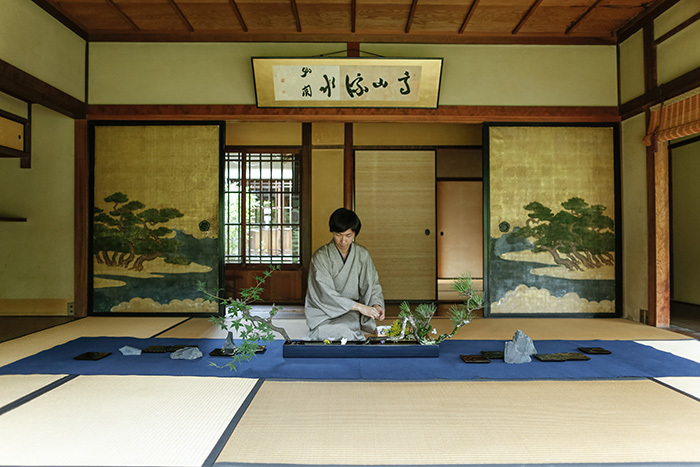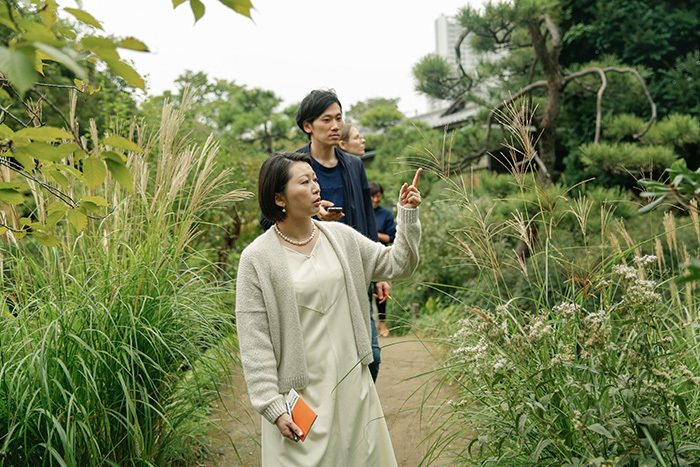Note: This website was automatically translated, so some terms or nuances may not be completely accurate.
What would you create? Discover ancient Japanese concepts that spark modern thinking here.

Hidetoshi Kurashige
Creative Project Base Co., Ltd.
<Table of Contents>
▼Have you heard of 4-Dimensional Open Innovation?
▼Immediately Applicable to Modern Business! Ancient Japanese Concepts
▼ "World Firsts" Born from Partnering with "Japan-Origin" Wisdom
Have you heard of 4-Dimensional Open Innovation?
Have you heard of the term "4-Dimensional Open Innovation"?
The latest theory from Silicon Valley!? A technique trending in Scandinavia!? Neither. This is a concept I proposed in the April 2018 issue of Forbes Japan.
Just to be clear, open innovation is defined as:
・Utilizing the inflow and outflow of resources such as technology and ideas, both internal and external, to promote innovation within an organization.
・This "external" refers to other companies, universities, local governments, social entrepreneurs, consumers, etc.
In other words, it means "partnering with the outside to create something new."
Naturally, the fundamental "partners" in open innovation are living people. What I proposed was: why not include the "past" as a partner too?
Now, this doesn't mean asking a medium to partner with the dead... or anything like that. It means partnering with the past, with historical ideas, cultures, technologies, anecdotes, and so on.
It's a bit different from "learning from the past to understand the present." Merely knowing isn't enough; you must create something new, or it remains just study. So, "learning from the past to innovate" is closer. Oh, I've coined another term.
In fact, in our own project,
・Morinaga Confectionery Store Development
・Arita Ware 400th Anniversary Project
・" Kodo-kan 2 " – an update for the 21st century of the domain school of the Nabeshima clan (※article)
we created new things by partnering with the past.
Actually, our Dentsu Inc. B Team itself was created by partnering with "Dentsu Inc.'s history." We frequented the corporate archives, immersed ourselves in the lecture transcripts and speeches of the 4th President, Hideo Yoshida, studied how past Dentsu Inc. departments operated, and incorporated methods we found effective. We even visited gravesites. We're probably the only active planning team digging this deeply into the company's past.
Now, the " Discover Japan Concept " service, born from ancient Japanese concepts to drive innovation. This, too, is 4D open innovation.
It creates something new by partnering with the ancient wisdom that lives within Japan's traditional culture. It's about partnering with our predecessors, transcending time and space. Doesn't that make you excited?
This time, we'll introduce several specific "ancient Japanese concepts" born from the Discover Japan magazine series.
Each concept, like the "Eight Parts Maker, Two Parts User" philosophy of Karatsu ware mentioned last time, was gathered through on-site research and "collected" directly from experts in the field. What new ideas would you come up with using these concepts? Think about it as you read.
Immediately Applicable to Modern Business! Ancient Japanese Concepts
■Concept: "Forty-Eight Teas, Hundred Mice" (Shijūhatcha Hyakunemuzu)
This concept originates from the traditional kimono pattern "Edo Komon".
During the Edo period, the shogunate issued the "Luxury Prohibition Edict" forbidding extravagance. Naturally, ornate clothing was banned. Amidst this, affluent townspeople would have dye shops create numerous subtle, understated colors that didn't appear flashy. They then enjoyed coordinating these pieces and appreciating their subtle differences.
The phrase "48 shades of brown, 100 shades of gray" originates from this practice, though the numbers themselves seem to have been used as examples of "many" rather than representing exact counts.

Inspired by this concept, what would you think of?
For example, a fast fashion brand might think, "Next year, we'll launch 100 shades of gray T-shirts exclusively at our flagship store in New York."
In a global society demanding speed, simplicity, and scale, this concept is perfect for conveying the value of "delicacy" to the world.
■Concept: "Four-Sided Front" (Shihō Shōmen)
This concept embodies the idea that "it stands as the front from any angle" and "different facets are visible depending on the angle."
Originally a term from flower arrangement, it refers to an arrangement that appears as the front view (and is enjoyable for the viewer) not just from one direction, but from any of the four sides.
Western floral arrangements are symmetrical, so they naturally look good from all sides. However, ikebana arrangements are asymmetrical, so the key point is that you can enjoy a different view from each direction.

This concept is also easy to apply. A four-sided television. A four-sided car. Etc...
Things that are currently one-directional—if you could use them from four directions, they'd become more convenient. There are things like that, right?
■Concept: "Interpretation"
According to the dictionary, it means "treating one thing as another for expression; likening." It's a term used across various genres, but we interviewed a master of Japanese confectionery.
Based on our interviews and experiences, we define it as "expressing all things—from the universe to the human heart—through a single object."
Take kinton, for example. In winter, white kinton is served to guests with the explanation, "This is snow." Guests respond, "Oh, snow," and savor it. In spring, it's made pink and served with, "This is cherry blossom." Then they exclaim, "Wow, cherry blossoms!" These two versions are actually made from the same ingredients. Yet, they are perceived not only as different in appearance but even in taste. (Amazing, isn't it?)

Metaphorical interpretation is a concept that works well in the business world. For example, imagine an advertising agency. If they declared, "Our goal isn't to be an advertising agency. We aim to be ◯◯◯◯!" it would broaden their scope of thinking.
What new thing could your business be likened to?
■Concept: "Tongue Twister" (Zettō Sentten)
"If the rhythm is off, twist your tongue a thousand times"
(If the rhythm is not right, let it turn a thousand times on the tip of the tongue)
This is a phrase recorded by Matsuo Basho's disciple, Mukai Kyōrai, based on Basho's teaching: When composing a verse, if you feel something is off, actually recite it aloud repeatedly to verify.
This teaching emphasizes not just writing the words, but repeating them aloud to let them permeate your body, thereby refining them into a good rhythm. The phrase "a thousand turns" is likely another metaphor for "many times."
This means trying out many prototypes quickly, which is the same as what's called "rapid prototyping" in the modern business world. Basho was saying this 300 years ago.

Basho's words show us that rapid prototyping isn't limited to physical products. If anything goes, what could you create in large quantities within your industry?
"World's First" Born from Partnering with "Japan-Origin" Wisdom
That's just a taste of five concepts from the "Collecting Japan's Hidden Wisdom" series previously featured in Discover Japan magazine.
Honestly, without conveying the on-site immediacy and the stories surrounding each idea, the inspiration might be limited... For more details, please purchase back issues of Discover Japan or ask us directly.
Based on these collected concepts, we've conducted workshops: for students in classes at Tokyo University of the Arts, and for corporate professionals at the "Nikkei Discover Japan Academy" seminars hosted by the Nikkei newspaper. We've proven that these workshops reliably generate new ideas.
For examples of what emerged, we've posted reports and videos toward the bottom of the Discover Japan Concept website. Please take a look if you're interested.
As you'll see, when combined with past wisdom, truly unexpected new things emerge. Moreover, unlike concepts imported from overseas, these are rooted in our own culture, making them easy to understand and grasp. I'm sure several ideas have already sparked in your mind while reading this article.
Beyond what we've introduced here, there are still many ancient concepts contributing to innovation. Roughly 70 have been gathered over the past four years. We've already conducted interviews on calligraphy, Buddhism, Noh, and Rakugo, and collected insights from tea ceremony, martial arts, shogi, and literature. But that's all for today.
One last thing. Why did I launch this project on tradition? There are many reasons.
- My parent was a tea ceremony instructor.
- Through work like the overall production of the 2010 APEC Summit, I seriously considered what "Japan's strengths" are.
- In 2007, I worked for six months at the studio of Marti Guixó, a Barcelona-based product designer featured in textbooks on speculative design. His final advice to me was: "Work while valuing the Japanese context!"
There are various reasons, but the deciding factor is that as long as I'm doing creative work, I'm interested in "wisdom."
Wisdom that transcends industry, country, and era—wisdom that can be applied anywhere. Especially inspiring wisdom that sparks someone's mind and sparks creation, and essential wisdom that enriches someone's life just by knowing it.
Japan, unable to see things from a long-term perspective, easily swept up by overseas trends, neglecting its own foundations. Someone has to raise questions about this. And who has to do it? Well... it's the person who notices. The truth is, once you notice, you feel compelled by a sense of mission that you have to do it yourself.
People might call me an idiot, but that's the feeling I started with. Fortunately, I've also been blessed with great companions.
Let's team up with the wisdom of our predecessors and create something only Japan can make. Let's do this "4D Open Innovation" together—collaborating with past wisdom across time and space. That's the kind of partner I'm looking for. I'm waiting for you. Let's create something incredible together. Something born in Japan, a world first, something that contributes to human progress.
Who knows? Maybe people in the distant future will see what we've created, get inspired, and team up with us across time and space.
【Event Announcement】
"The 2nd Nikkei Discover Japan Academy in Nihonbashi" is confirmed!
This year's practical workshop returns to help participants learn traditional Japanese sensibilities and values cultivated in Japan, and apply them to developing new products and services. Speakers include Hidetoshi Kurashige and Nadezhda Kirillova from Dentsu Inc. B Team.
Registration is only open to teams of 5 people per company/organization. The application deadline is September 30 at 5:00 PM. For details, please refer to the website below.
https://events.nikkei.co.jp/17530/
Was this article helpful?
Newsletter registration is here
We select and publish important news every day
For inquiries about this article
Back Numbers
Author

Hidetoshi Kurashige
Creative Project Base Co., Ltd.
Representative Director/Creative Project Director
Joined Dentsu Inc. in 2000 and was assigned to the Creative Bureau. Since then, expanded and applied advertising skills to lead diverse projects across genres, including collaborations with corporate new business divisions, overall production of APEC JAPAN 2010 and the Tokyo Motor Show 2011, and the 400th anniversary project for Arita ware in Saga Prefecture. Launched Dentsu B Team in 2014 with employees possessing personal B-sides. In 2015, he established the Active Learning "How About This?" Research Institute. On July 1, 2020, he founded Creative Project Base Co., Ltd.

